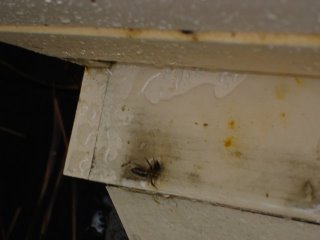
It's pouring in Atlanta, as it did yesterday. Ultimately the bees will be glad because we've had weeks with no rain, but the rain also causes problems for the bees.
There is a growing puddle on the front porch of Bermuda. The bees continue to leave and return to the hive, even in the rain. The numbers are much smaller than on sunny days, and I have to think these are the suicidal bees in the hive who leave.
The struggle to land and enter or leave the hive is complicated by the large puddle on the landing.

The bees slip onto their backs in the puddle where unless they can turn over, they will drown. You can see orange pollen in the puddle which has been lost from the bees' legs as bees flail in the pool.

In the last picture you can see the motion in the water caused by the bee using her wings to help her turn over.
This morning every bee I saw in the water managed to turn herself over except for one drone (who probably WAS on a suicide mission) and I gently pushed him off with a pine needle. On the ground he righted himself. Yesterday my daughter Valerie helped a bee in the same way and the bee was able to fly from the deck.
I've always wished for a tin roof to hear the rain. My bees can listen to the rain drumming on their roof all of this rainy day.

I do know from what I have read that drumming is disturbing for the bees. If you are trying to get a swarm out of a tree hollow, for example, drumming the tree with a regular beat below the opening is one way to get the bees to leave the tree.
I wonder what the effect of an all-day tin roof drumming has on the bees? Maybe this is why some of them leave to forage in spite of the rain - the drumming drives them out of the hive!

just a quick cure for your puddle issue. Take the bottom board off and make grooves running vertically on the ramp. For the landing pad I would do the same with matching grooves coming from the hive to the ramp. You could use a saw, but a good knife would probably do. I would start with a ruler and mark every inch, every half inch, and so on until you think you have enough there to allow the water to run off the pad. Once the surface tension is broken on the ramp the water will follow the groove and off the landing area of your bees. it will also give the bees a good place to grip when they land and give them purchase when they end up upside down. just my two cents worth.
ReplyDelete